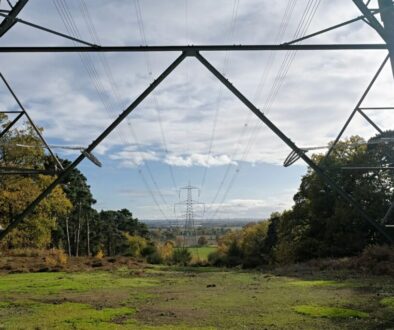Are rural areas falling through the net?
The digital divide is the gap between people who have full access to digital technologies and those who do not. COVID-19 has underlined the importance of access to and comfort with technology. Throughout the pandemic the internet and digital devices have played a vital role in enabling people to access services, attend medical appointments, use contact tracing apps, learn or work from home and keep in touch with friends and family. Just imagine how much worse your life would be if you didn’t have proper functioning broadband. This is the reality for many rural residents who are either not connected at all or reliant on 20th century infrastructure. What impact has the digital divide had on rural residents during the pandemic, and what more needs to be done to get everyone connected? Jessica Sellick investigates.
………………………………………………………………………………………………..
What is superfast broadband and full-fibre broadband? Back in December 2010, the Government published its superfast broadband strategy. Since then, Government policy has focused on the roll-out of superfast broadband, which it defines as ‘download speeds of at least 24 megabits per second (Mbps)’. According to Ofcom, and based on this definition, superfast broadband availability reached 95% of UK premises in February 2018. While Government focused on promoting a competitive market for the rollout of infrastructure, it also initiated a superfast broadband programme to support delivery in those areas not reached by the private sector. Under the programme, Government has been providing some £719 million in funding to Local Authorities and/or Local Enterprise Partnerships (LEPs) to subsidise roll-out in areas not reached by commercial investment. The programme is ongoing, accounting for approximately 17% of the county’s total superfast coverage, with contracts expected to run until 2024. In October 2020, the National Audit Office (NAO) published a report on the programme. While the NAO found the programme had helped to extend coverage, many people were found to be still experiencing poor broadband – particularly in rural areas. It is worth noting that only 57% of properties were found to have signed up to superfast broadband packages (owing to lack of awareness that faster services were available and/or cost) and that premises do not necessarily experience the advertised speeds (attributed to distance from the cabinet or multiple users in the home or workplace).
Superfast broadband has been mostly delivered by Fibre-to-the-Cabinet (FTTC) technology. This is where a fibre optic cable runs to a street cabinet, and then existing copper telephone wires are used to connect the cabinet to individual premises. The copper telephone network is owned and operated by Openreach, which allows other broadband retail providers to deliver broadband services using this network.
While superfast broadband has been fast enough for most individual/household needs; the availability of, and demand for, data intensive services (e.g. video calling, virtual meetings) is increasing. To support this, high capacity internet connections that can support fast download speeds, large amounts of data, and multiple users at one time, will be required. Fibre-to-the-premises (FTTP) or fibre-to-the-home (FTTH) can deliver 1 gigabit per second (Gbps) download and upload speed. This is where fibre optic cables run from the cabinet to premises – these can carry more and faster data when compared to copper wiring. Investment in fibre networks requires access to every premise to install equipment – negotiating this (and variances across different Local Authority areas) and build costs may be expensive for commercial providers leading to an inconsistent approach. Similarly, 5G is the next iteration of high capacity broadband networks. 5G is expected to support very fast download speeds and near instant response times. However, with some rural areas lacking 4G coverage there is a risk that rural areas will be left behind in the mobile roll-out, compounding the lack of broadband connectivity.
Why are some rural areas ‘hard to reach’? Rural areas are typically more expensive to deliver broadband to. This is because the geographies of some rural areas increase installation costs, and low population densities [fewer chimney pots!] reduce the commercial return for providers.
In December 2020, the Government announced £5 billion of funding to support the roll-out of gigabit capable broadband in ‘the hardest to reach 20% of the country’. In the Spending Review 2020, the Chancellor confirmed £1.2 billion of this sum would be made available during the period 2020-2025. In March 2021, the Government published a ‘Build Back Better: our plan for growth’. This seeks to achieve economic recovery from COVID-19 through building three pillars of investment: infrastructure, skills and innovation. This confirmed £5 billion to accelerate UK-wide gigabit broadband roll-out, a Shared Rural Network extending 4G mobile coverage to 95% of the UK and £250 million to ensure resilient and secure 5G networks and £50 million for the continuation of the 5G Testbeds and Trials Programme in 2021-22. Rural areas and parts of Scotland, Wales and Northern Ireland are cited as the beneficiaries of this investment.
It is likely the investment will be managed by Building Digital UK (BDUK), part of the Department for Culture, Media & Sport (DCMS). In the meantime, existing Government funded programmes to support gigabit capable broadband include: the Rural Gigabit Connectivity Programme (RGC) – which includes a voucher scheme for rural residents and small and medium-sized businesses (SMEs) without broadband speeds of 100 Mbps to put towards the cost of a gigabit capable connection. SMEs can claim up to £3,500 and residents up to £1,500 although they can only be used to support group schemes where residents come together and combine their vouchers. Providers have to request vouchers on behalf of businesses and residents. A map shows where vouchers are available and how they have been allocated – as of October 2020 the scheme had issued vouchers worth £33.5 million. Some full fibre operators including B4RN, Gigaclear and TrueSpeed specifically target rural areas.
In September 2020 seventeen Local Authorities were provided with £22.2 million of additional funding to top-up Government vouchers in their area. These include Buckinghamshire, Cambridgeshire & Peterborough, County Durham, Derbyshire, Dorset, East Riding of Yorkshire, East Sussex, Warwickshire, West Sussex and Worcestershire. This complements the RGC programme which has been connecting rural public sector buildings such as schools and hospitals to a gigabit connection, with these buildings acting as ‘hubs’ in improving access to services and making the surrounding area more viable for commercial providers. In England, this has initially prioritised sites in Cornwall, Cumbria and Northumberland.
In all of this investment, the Government seeks to adopt an “outside in” approach, which means targeting the hardest to reach premises first. This follows the publication of the Future Telecoms Infrastructure Review (FTIR) back in 2018 which suggested deployment of gigabit capable connectivity across all areas of the UK should be achieved at the same time so no areas are systematically left behind. This approach also means that while competition serves the commercially feasible areas, the Government will support investment in the most difficult to reach areas at the same time- this was estimated to be 10% of the total target (some 3 million premises). A staged process of investment was suggested, starting with areas that do not have superfast broadband [5% of the total target]. In November 2020, the Government confirmed in oral evidence to the Public Accounts Committee that outside-in is “still baked into our planning for the future programme. In a sense, we are trying to ensure that the commercial market goes as far as possible, and alongside that we can target our subsidised parts of the programme on the areas of greatest need…when you look at a cost curve for the most difficult premises, they are not all neatly grouped together”. However, the timeline, process and costs for doing this remain unclear therefore leading to a risk that some rural premises will be left behind.
An increasing rural digital divide? According to the NAO, the superfast programme in the UK has enabled suppliers to prioritise easier-to-reach premises, leaving a rural divide in place because they are the hardest and most expensive to reach. There are also concerns that if rural areas have only one provider they may get locked in to higher prices. The NAO estimates that rural coverage in the UK is 80% – this compares to 97% in urban areas. Overall, England has higher coverage than the devolved administrations. While urban coverage is broadly the same across the four nations, rural coverage varies and, at 66%, is lowest in Northern Ireland. The NAO’s data is drawn from Ofcom and based on actual and predicted data from network operators. The speeds achieved in practice may be higher or lower than those predicted.
In January 2021, the Public Accounts Committee published its report on improving broadband. This describes how ‘1.6 million UK premises, mainly in rural areas, cannot yet access superfast speeds, and as the Department [DCMS] turns its attention to upgrading the UK’s broadband connectivity again, there is a risk that rural areas will be left even further behind’. The Committee also highlighted a concern that those living in rural areas may have to pay more and may reach gigabit broadband speeds late. The report recommends that the Department [DCMS] set out how it will establish which premises do not yet have superfast broadband, how reliable the data it will use to identify them is, and when they can expect to receive gigabit capable broadband. Without a clear plan the report suggests those living in rural and remote areas may not get superfast speeds until 2024-2025.
What impact has the digital divide had on rural communities during COVID-19? The term ‘digital divide’ is being used by practitioners and academics to describe ‘the gap that exists between individuals who have access to modern information and communication technology and those who lack access’. There are multiple dimensions to the digital divide, including: access: to hardware and software data; use: the skills and knowledge to use technology and handle updates to it; confidence: that it is safe and secure to use; money: to pay for the connection and technology; time: to fully utilise it; and family and peer support: which enables it to form part of our everyday lives.
Between December 2019 and February 2020 Capgemini surveyed 1,300 people with no internet access in the UK, France, Germany, Italy, Sweden and the US. More than 40% of those surveyed were aged 18-36 years and many described being unable to get information about the virus, talk to relatives, interview for jobs, or access welfare programmes and banking services. For those living in rural areas, cost was the key reason for being offline: nearly half (47%) said they had never used the internet because an internet subscription was too expensive and 44% said the device was too expensive. The share of households living in rural areas accessing the internet daily stood at only 62% (versus 88% in cities), driven by higher costs and long implementation times of broadband in rural areas.
According to the NAO’s report the existing infrastructure has coped well with increased demand for the internet during the pandemic – but it acknowledges that rural populations with poor broadband had felt the impact more sharply. Ofcom estimates that a small but significant number of premises have been struggling to get connected – some 43,000 premises that cannot access either a decent fixed broadband service or good 4G coverage indoors. In 2020, consumer use of fixed broadband increased by an average of 2.5 hours a day, and on mobile by 1 hour a day.
The Good Things Foundation has found since lockdowns began libraries and internet cafes that many use to get online have closed. Others who have a smartphone but struggle to pay for data have not been able to access free hotspots. The Foundation is working with the Prince’s Countryside Fund to tackle the inequity that means 11% of rural premises in England still cannot get access to a good broadband connection, compared to 1% of urban premises. The project is looking at how to scale lack of digital skills and/or digital connectivity across rural communities. This includes the creation of Digital Enterprise Hubs and Digital Enterprise Champions. The two current Digital Hubs are A1 Community Works (North Yorkshire) and Airedale Enterprise Services (West Yorkshire). The Foundation has also recommended the establishment of a ‘data poverty lab’, which recognises broadband as an essential utility like water and electricity. It has suggested the lab could facilitate initiatives like data donating whereby people can donate unused mobile data to others who cannot afford it; Wi-Fi sharing between neighbourhood households; subsidised broadband schemes; and extending public Wi-Fi in towns and cities.
While initiatives are underway to understand the digital divide in relation to home-schooling and online distance learning or workplace skills; the focus often remains on the main factors that shape the digital divide (i.e., age, region, socio-economic status and whether a person has a disability) rather than applying any kind of rural lens.
What more can be done to ensure no-one is left behind? In its National Infrastructure Assessment, the National Infrastructure Commission (NIC) recommended that the Government develop a plan to allow a copper switch off by 2025. This means all customers/premises would move from a copper to non-copper based network. While running a copper network alongside a fibre network is costly, there are customers without any broadband connection and vulnerable customers relying on the copper network for telephone calls. The Government is referring to a switchover instead, with customers/premises moving over to new non-copper based networks. This is important because as yet there is no date for 100% coverage and no date for when those without superfast access can expect better broadband.
HM Treasury published a National Infrastructure Strategy in November 2020. This explicitly references rural areas as part of the Government’s levelling up agenda. Under a section titled ‘leaving no community or business behind’, the Strategy references the existing UK-wide gigabit broadband roll-out and a Shared Rural Network to extend 4G mobile coverage to 95% of the UK.
In the Budget presented on 3 March 2021, the Chancellor described how the UK has a relatively low adoption of digital technologies and software compared to international competitors, and how this directly affects productivity. The budget made provision to support SMEs to boost their digital and management capabilities [help to grow digital programme to upskill 100,000 SMEs with advice and software worth up to £5,000 each]; saw the establishment of a UK Infrastructure Bank with £12 billion of equity and debt capital to finance local authority and private sector infrastructure projects across the UK; and £375 million allocated to help scale up the most innovative, R&D intensive businesses.
We need a better understanding of what is connectivity really like in rural areas. Should having a broadband internet ‘service’ be treated as a basic ‘utility’ and critical infrastructure, or as a ‘nice to have’? Mobile phone coverage remains as much of an issue as broadband in many rural areas.
We need quicker, smarter, affordable and future-proofed [fibre] solutions to connect rural communities. In addition to the delivery infrastructure put together by the Government, how can residents and businesses deliver broadband in their area? There are a plethora of examples of where communities have decided to get on and ‘do it yourself’ (e.g. Cybermoor) and some rural communities will not have access to high speed broadband unless they take more action. How can we encourage rural communities to come together and solve the connectivity conundrum that they are facing? For example, where and how can communities be supported to obtain access to finance, technical skills and infrastructure? Should digital access form part of planning considerations for new developments in rural areas? Regardless of how it is delivered, for those living in rural areas lucky enough to get full fibre during the pandemic, it has had transformative effects in how they live, work and socialise.
Finally, it is worth noting that broadband is not a catch-all solution to the issues facing rural communities – it needs to be joined up. It is important that we do not impose ‘online solutions’ to ‘offline issues’. Yet if the Government views digital infrastructure as central to the future of the economy – and vital to its levelling up agenda as we recover from the pandemic – them every part of the country, including rural areas, needs to benefit. While policy and decision makers have been providing a plethora of initiatives and funding pots since 2010, and want to follow an outside in approach, to what extent we will finally reach the final 11% remains to be seen. Will it be by 2024-2025 or from 2026, watch this space…
…………………………………………………………………………………………………
Jessica is a researcher/project manager at Rose Regeneration and a senior research fellow at The National Centre for Rural Health and Care (NCRHC). Her current work includes supporting health commissioners and providers to measure their response to COVID-19 and with future planning; and evaluating two employability programmes helping people furthest from the labour market. Jessica also sits on the board of a Housing Association that supports older and vulnerable people.
She can be contacted by email jessica.sellick@roseregeneration.co.uk.
Website: http://roseregeneration.co.uk/ https://www.ncrhc.org/
Blog: http://ruralwords.co.uk/
Twitter: @RoseRegen



